Best WordPress Redirect Plugins
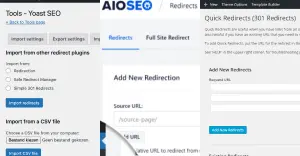
The integrity of your WordPress website plays a pivotal role in ensuring a seamless user experience and achieving higher search engine rankings.
One aspect that often gets overlooked is the presence of broken backlinks, which not only tarnish your site’s SEO but also hinder the user experience.
These malformed or non-existent links are like dead-ends in your website, leading visitors nowhere.
WordPress, being a versatile platform, offers a myriad of redirect plugins to combat this issue.
In this guide, we’ll get right to the point by recommending you the best redirect plugins. However, if you’d like to read more on the topic then use this helpful table of contents, or scroll to the end of the article.
Table of Contents
Best WordPress Redirect Plugins to Consider
Redirecting broken links is an essential task for any website owner, and WordPress makes this task easier with several redirect plugins. Here are the best redirect plugins that can help you manage and fix broken backlinks on your WordPress site.
The first three plugins that I have recommended are All-in-One SEO plugins – meaning they can do a lot more than redirect users. The reason for this, is that generally speaking single use plugins aren’t good for your site and can lead to issues down the road.
RankMath – Amazing All Round SEO Plugin
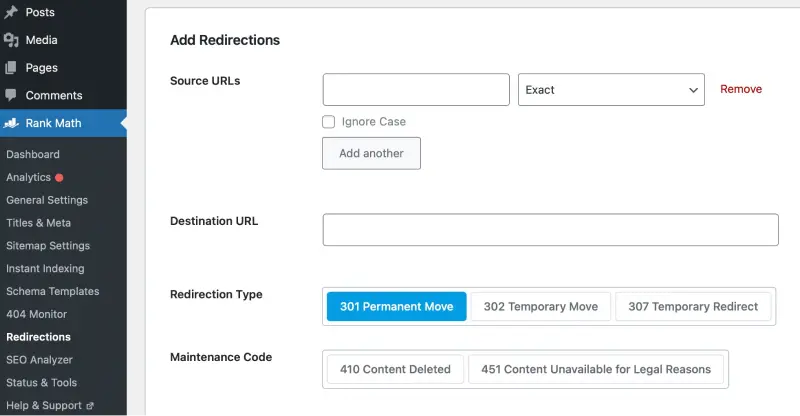
RankMath is one of, if not the, best SEO tools available on the market. Naturally, it will help you combat broken links. For this it has two useful features:
- An easy-to-use custom redirects manager manager to fix broken links
- A broken link checker
Alongside this, it has a myriad of features to help you with improving the technical SEO of your website. From baseline SEO analysis to in-depth Schema they have it covered.
RankMath offers a free version with basic redirection features, and a pro version starting at $59/year.
Yoast SEO – The SEO Manager for Beginners
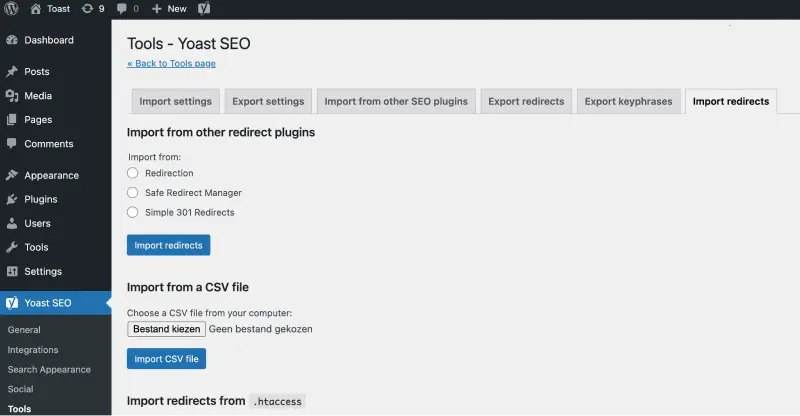
Similarly to RankMath, Yoast is an all in one SEO tool to help you improve the rankings of your website. It’s considered to be one of the first plugins to really dominate this market due to their amazing product offering. Naturally, a useful redirect manager is a part of this. However, due to some issues in the past, and fewer advanced features it comes in second place.
At 99Eur/ year a Yoast SEO premium subscriptions is also more expensive, but it does have some unique selling points and generally offers better cross compatibility with other plugins, themes, and WordPress versions.
All in One SEO – Yet Another All-in-One SEO Plugin
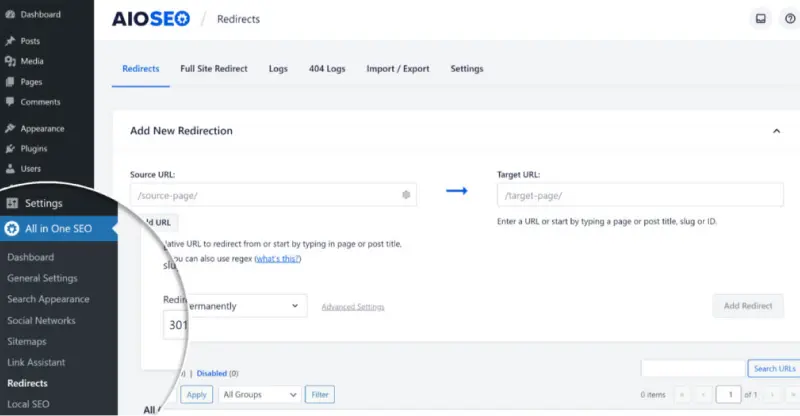
Like the two before it AIO SEO is another All-in-One SEO WordPress plugin (surprise surprise). Alongside the possibility to redirect URLs it has a range of features to help improve the SEO of your website. Similarly to RankMath, it supports advanced Schema, and personally I prefer it’s slightly cleaner user interface and experience.
Starting at $49.60/ year it’s great value for money and a valuable addition to any other site.
Redirection – Best Dedicated WordPress Redirection Plugin
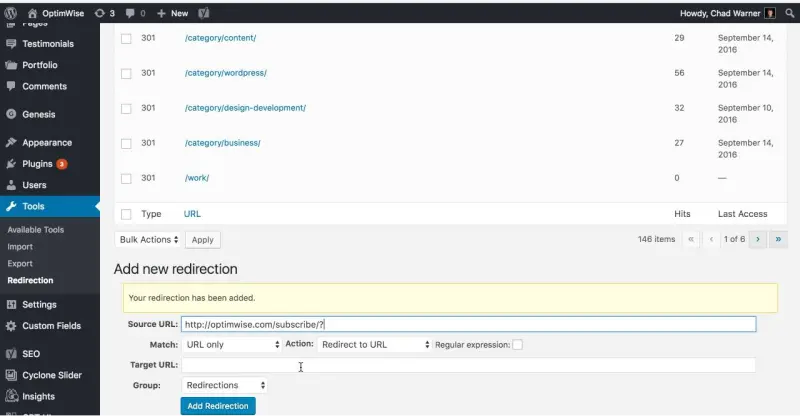
While fixing redirects with an all-in-one SEO plugin can be amazing their redirection features can be limited. Redirection is a highly regarded redirect manager for WordPress, enabling users to manage 301 redirections, monitor 404 errors, and enhance site ranking. On top of this, it allows conditional redirects, fine-grained permissions and is completely free! So if you need something that’s a bit more in-depth, then this is the plugin to choose.
Quick Page/Post Redirect – The Quick WordPress Redirect Plugin
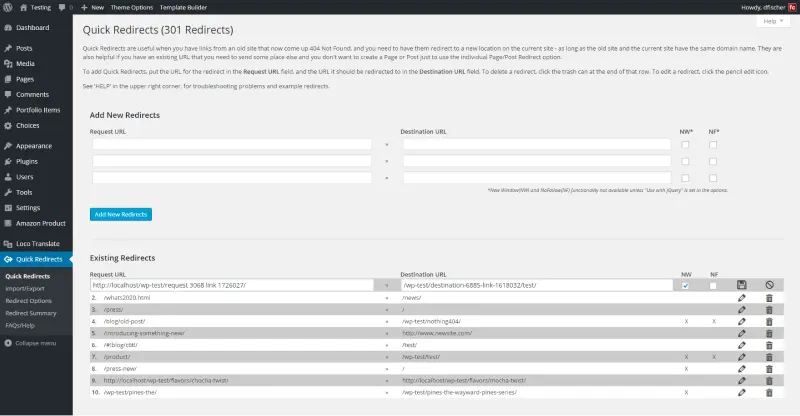
This plugin, similarly to the Redirection plugin, acts as a standalone redirect tool. It acts very similarly with most of the same feature sets. One useful feature is that it can rewrite the href at the post level, thereby actually removing the 301! If you’re looking for a standalone option I’d recommend choosing downloading and testing both in order to find out which one you prefer.
Understanding Broken Backlinks
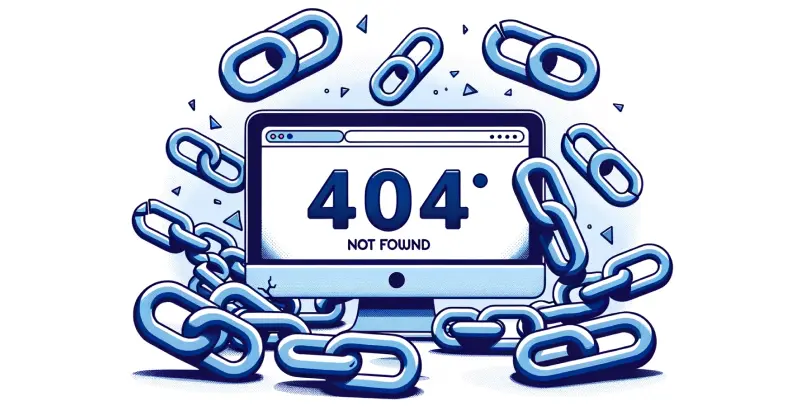
In this section, we’ll discuss what broken backlinks are and how they can affect your site.
What Are Broken Backlinks?
Broken backlinks, also known as dead links, occur when a webpage links to another page that has been removed or relocated. When users follow such links, they usually encounter a 404 error page, indicating that the desired page is not available.
“Backlinks are one of the main factors that search engines, specifically Google, consider when ranking a site organically. Backlinks signal to search engines that your site is authoritative, credible, and relevant. The more links you have, the higher your likelihood of ranking. That is, of course, except for the broken ones”
Morgen Henderson, Portent
Apart from the common 404 errors, users may also experience one of these issues.
| Error Code | Error Name | Description |
|---|---|---|
| 401 | Unauthorized | You aren’t allowed to access the page due to valid authentication request. |
| 403 | Forbidden | The server understands your request but blocks you due to some reason. |
| 404 | Not found | The resource/ URL doesn’t exist |
Why Are Broken Backlinks Bad for SEO?
Search engines, like Google, aim to provide the best user experience possible by directing users to high-quality, relevant content. Broken backlinks hinder this objective as they lead users to dead-ends. Consequently, a site with numerous broken backlinks can suffer in search engine rankings. Moreover, broken links can dilute link equity, a crucial factor for SEO, as they waste the linking value that could have been passed to live pages.
The User Experience Fallout
Imagine a user enthusiastically following a link, expecting to find valuable information, only to stumble upon a 404 error page. It’s frustrating and can negatively impact the user’s perception of your site. Over time, a poor user experience due to broken backlinks can lead to decreased traffic and a lower return visitor rate.
A study by WooRank revealed that 12.2% of e-commerce site backlinks pointed users to a 404 page, showcasing the widespread issue of broken backlinks in the online retail sector. Just consider the value of the sales they’re missing out on.
Ecommerce SEO Audit, WooRank
The Importance of Redirects

What Is a Redirect?
A redirect is a way to send both users and search engines to a different URL from the one they originally requested. This is particularly useful when a page has been moved to a new location. Redirects can be temporary or permanent, with the latter being most common for fixing broken backlinks.
How Redirects Resolve Broken Backlinks Issues
Redirects serve as a bridge to mend the gaps caused by broken backlinks. By setting up a redirect, you ensure that visitors who click on a broken link are taken to a relevant page instead of facing a 404 error. This not only improves the user experience but also retains the link equity, which is beneficial for SEO.
Types of Redirects
Chances are you’ve only used or heard about 301 redirects in your life. However, in total, there are four different types.
| Redirect | Redirect Name | Description |
|---|---|---|
| 301 | Moved Permnanently | A full ‘power’ redirect that you don’t intend to change in the future. |
| 302 | Found | A redirect that you’re only using for a short time, for example for a promotion or testing |
| 307 | Moved temporarily | A successor to 302 redirects. Only to be used in true instances. |
| Meta | Meta Refresh | Redirects that happen once a user is on the site. You can often see these with ads or spam and hence are often ill-advised. |
Redirects Not to Use a Plugin For
There are two cases of 404 errors that you should not use a redirect plugin for:
- HTTP to HTTPS redirect
- non-www to www redirects (or vica-versa depending on your chosen core domain)
The reason being is that these are sitewide and unless you fix them at the core (or use a wildcard rule) it will constantly produce errors.
We would recommend using a htaccess rule for this as follows. You can find out more about how this works here.
RewriteEngine On
RewriteCond %{HTTPS} off [OR]
RewriteCond %{HTTP_HOST} ^www\. [NC]
RewriteCond %{HTTP_HOST} ^(?:www\.)?(.+)$ [NC]
RewriteRule ^ https://%1%{REQUEST_URI} [L,NE,R=301]How to Choose the Right Redirect Plugin for You
The right redirect plugin can make the process of managing and creating redirects simple and efficient. It allows for easy monitoring and correction of broken backlinks, and provides insights on how redirects are impacting your site. Choosing a plugin that is user-friendly, highly-rated, and packed with useful features is essential for effectively managing redirects and improving your WordPress website’s SEO health.
Choosing the right redirect plugin is crucial as it will significantly impact how effectively you can manage redirects and resolve broken backlinks issues on your site. Here are some factors to consider when choosing a redirect plugin:
- Ease of Use: Look for a plugin with a user-friendly interface that makes managing redirects simple.
- Features: Ensure the plugin has the features you need
- Support and Updates: Choose a plugin that is well-supported and regularly updated to ensure compatibility with the latest WordPress versions.
- Pricing: Consider your budget and compare the pricing of different plugins. Some plugins offer a free version with basic features, while others require the purchase of a premium version for in-depth options.
- Ratings and Reviews: Check the ratings and reviews to gauge the plugin’s reliability and performance from other users’ experiences.
Features
Talking about features, here is a list of features that you’ll need to consider if you’d like to go beyond simple redirecting Page A to Page B.
- Import and Export Redirects. This can be important if you’re moving to new redirect manager
- Wildcard Redirects. If you’re making significant changes to a site it can be important to be able to redirect a range of URLs en masse using regex query parameters.
- Create Custom Redirects. Create redirects based on more than just the origin URL and have an adaptive destination URL.
- Automatically Create Redirects. If you delete a page/post it’s useful if you don’t need to worry about separately setting up a redirect.
Be Vary of Multiple Redirection Plugins
During my years of freelancing as an SEO specialist I came across sites with multiple plugins used for redirection. Whether it’s your own website or a clients be vary of this issue! Not only can it cause issues with the redirects themselves, but it can also have an impact down the line on the stabilit
Implementing Your Chosen Plugin
Once you have chosen the right redirect plugin for your needs, it’s time to implement it on your WordPress site. Here’s a step-by-step guide on how to set up a WordPress redirect plugin:
- Installation:
- Go to the WordPress dashboard.
- Navigate to Plugins > Add New.
- Search for the redirect plugin you chose.
- Click on “Install Now” and then “Activate.”
- Setting Up Redirects:
- Navigate to the redirect plugin’s settings page.
- Create a new redirect by specifying the old URL and the new URL.
- Choose the type of redirect (e.g., 301 permanent redirect).
- Save your settings.
- Monitoring and Managing Redirects:
- Regularly monitor the redirect log (if available) to ensure redirects are working as expected.
- Keep an eye on the 404 error log to identify new broken links and set up redirects accordingly.
- Update or remove redirects as necessary when URLs change.
- Maintenance:
- Keep the redirect plugin updated to the latest version to ensure ongoing compatibility and security.
- If the plugin offers an import/export feature, consider exporting your redirects as a backup.
Other ways of redirecting
WordPress plugins are the common choice by users to redirect content. This is due to their straightforward and easy to use nature. However, they aren’t the only option. If you’re using an Apache server, you can also use a .htaccess file to redirect multiple URLs.
To do this, follow these steps:
- Log in to your server using FTP (you can get the details of this from your hosting provider)
- Alternatively, some plugins allow you to edit the file without having to log in through FTP
- Navigate to the public_html folder
- There, you should see a file called .htaccess
- If you can’t, check that hidden files/ folders option is enabled in your FTP tool
- If it doesn’t exist create one using a plain text editor
- Create a backup of this file! An incorrectly configured htaccess file can completely break your site
- At the end of the file write the below code and save
- That’s it, now just check that it has worked correctly
RewriteEngine On
Redirect 301 /outdated-post/ http://yourwebsite.com/recent-post/Conclusion
Handling broken backlinks is a crucial aspect of maintaining a user-friendly and SEO-optimized WordPress website. Redirects play a pivotal role in resolving the issues caused by broken backlinks, and a good WordPress redirect plugin makes managing these redirects a breeze. With the right plugin, you can easily create redirects, monitor broken links, and ensure your visitors have a seamless experience, all while enhancing your site’s SEO.
The redirect plugins discussed in this guide are among the best in the industry, each with its unique features and capabilities. Whether you choose RankMath, Yoast SEO, All in One SEO, Redirection, or Quick Page/Post Redirect, you are taking a significant step towards improving the user experience and SEO health of your WordPress site.
Investing time in understanding the intricacies of broken backlinks and the importance of redirects, along with choosing the right redirect plugin, will pay off in the long run. It’s an investment in your site’s future success and a step towards a better user experience and higher search engine rankings. So, take the time to choose the right WordPress redirect plugin, set up your redirects, and watch your site thrive in the organic search landscape!

Written by Peter Selmeczy
As the Head of Growth at AutoSEO I love everything about content, SEO, and AI. Hope you like my musings and would love to talk to you in the comments.



